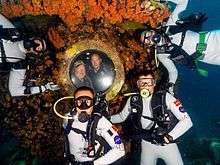Andreas Mogensen
| Andreas E. Mogensen | |
|---|---|
 | |
| ESA Astronaut | |
| Nationality | Danish |
| Status | Active |
| Born |
November 2, 1976[1] Copenhagen, Denmark |
Other names | Andreas Enevold Mogensen |
Other occupation | Aerospace engineer |
Time in space | 9d 20h 14m |
| Selection | 2009 ESA Group |
| Missions | Soyuz TMA-18M/Soyuz TMA-16M |
Mission insignia |
|
Andreas Enevold Mogensen, Ph.D. (born November 2, 1976) is a Danish engineer and astronaut. He was the first Dane to fly in space as part of the iriss programme.[2]
Biography
He was born in Copenhagen. In Denmark he worked as an engineer in the R&D department of Vestas Wind Systems. He has worked in Germany as an attitude and orbit control system and guidance, navigation & control engineer for HE Space Operations associated with the SWARM mission. His position when he was selected by ESA was Aerospace Engineering at Surrey Space Centre, University of Surrey. He currently lives in Cologne, Germany.
Career
During his career Mogensen has also spent time in Thailand, Singapore, Portugal, Congo, and the United States. His pastimes include rugby, mountaineering and diving.
Mogensen was selected to become the first Danish astronaut by the European Space Agency in May 2009. He completed initial training and became a member of the European Astronaut Corps in November 2010.
On 10 June 2014, NASA announced that Mogensen would serve as an aquanaut aboard the Aquarius underwater laboratory during the NEEMO 19 undersea exploration mission, which began on 7 September 2014 and lasted seven days.[3][4]

Iriss
Mogensen’s mission to the ISS was called "iriss". The mission name was chosen from suggestions received from across Europe. "iriss" had two logos, one to highlight the overall mission and one for the educational outreach activities.
On 2 September 2015, Mogensen was launched with Soyuz TMA-18M to ISS, and landed with Soyuz TMA-16M ten days later. He was travelling with another visiting flight engineer, Aidyn Aimbetov. Among the items Andreas brought along were LEGO figures[5] and a poster for Copenhagen Suborbitals.[6]
Because of the short mission duration, Mogensen worked up to 9.5-hour days instead of the 8-hour workdays that are normal on the station.[7] His missions included remote control of a robot on Earth,[8] and filming Red Sprites and Blue Jets lightnings above thunderclouds,[9] directed from Earth.[10] He also tried a new kind of Skinsuit to alleviate back-pain astronauts feel due to the lengthening of their spine and used augmented reality goggles during his maintenance tasks.[7]
Mogensen left the station on 11 September 2015. Sergey Volkov was the ascent pilot (TMA-18M) and Gennady Padalka was the descent pilot (TMA-16M).[11] The crew landed at 00:51 UTC on 12 September 2015, just over three hours after departing the ISS.
Mogensen received the Danish Royal Medal of Recompense for his efforts.[12]
Education
- O-Levels at Rygaards International School, Denmark, 1993[13]
- International studentereksamen at Copenhagen International School, Denmark, 1995[14]
- Master of Engineering degree in Aeronautical Engineering at the Imperial College, London, 1999
- Ph.D. degree in Aerospace Engineering at the University of Texas, Austin, 2007
References
- ↑ "Andreas Mogensen - den første danske astronaut". Rumrejsen 2015.
- ↑ "Andreas Mogensen: Space Viking". European Space Agency. Retrieved 3 September 2015.
- ↑ "NASA Announces Two Upcoming Undersea Missions". NASA. 10 June 2014. Retrieved 24 June 2014.
- ↑ Bergin, Chris (11 June 2014). "NEEMO returns with two new underwater missions". NASASpaceflight. Retrieved 24 June 2014.
- ↑ "The story behind the LEGO astronauts". iriss mission blog.
- ↑ "Good luck, @CopSub (Andreas Mogensen on Twitter)". Twitter. Archived from the original on 2015-09-16.
- 1 2 "Iriss - A Sprint Mission". ESA.
- ↑ (Danish) http://ing.dk/video/video-saadan-udfoerte-andreas-robotforsoeget-fra-rummet-178545
- ↑ (Danish) http://rumrejsen.dk/nyhed/k%C3%A6mpelyn
- ↑ (Danish) "How DMI found giant lightning for Andreas". Danish Meteorological Institute. Retrieved 17 September 2015.
- ↑ "UK's Major Peake delighted by historic ISS assignment". nasaspaceflight.com. 20 May 2013.
- ↑ "Astronaut Andreas Mogensen modtager Den Kongelige Belønningsmedalje i guld med krone og inskription". kongehuset.dk.
- ↑ "Former Rygaards Student Blasts Into Space!". rygaards.com.
- ↑ (Danish) Første danske astronaut slog en tur forbi Hellerup Archive
External links
| Wikimedia Commons has media related to Andreas Mogensen. |
- Andreas Mogensen blogs about space and the life as an astronaut on the science website Videnskab.dk (in Danish) Blog on Videnskab.dk
- Biography Lightsey Research Group
- ESA prepares for the next generation of human spaceflight and exploration by recruiting a new class of European astronauts ESA
- Spacefacts biography of Andreas Mogensen
- Texas Grad Rugby and Rugby Club Konstanz Andy's Rugby Teams
- Collection of articles on Ingeniøren (The Engineer)

